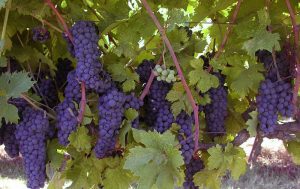
Despite regulatory uncertainty, biostimulant product use in California vineyards is increasing, UCCE Viticulture Advisor Joy Hollingsworth confirms, but growers should be aware of product limitations and carefully read labels.
Match the product with what you want to achieve, said Hollingsworth.
She notes biostimulant products are not intended to be fertilizers though they may contain some nutrient compounds.
Hollingsworth said some biostimulant products could be viewed as an ‘assist’ to fertilizer. The products may contain 1% to 2% nitrogen but are not meant to be a replacement for fertilizer.
Biostimulants are biological products that are applied to plants or soil to achieve improved plant growth. Depending on the type of biostimulant, the products are intended to reduce plant stress or aid in nutrient uptake with increased soil microbe activity. Other claims of benefits achieved with biostimulant use, including carbon sequestration and improving water quality, would depend on timing of application, soil type or other environmental conditions.
As defined in the 2018 Farm Bill, “Biostimulants are a substance or microorganism that, when applied to seeds, plants or the rhizosphere, stimulate the natural processes to enhance or benefit nutrient uptake, nutrient efficiency, tolerance to abiotic stress or crop quality and yield.”
In 2019, an EPA report defined biostimulants in a similar way, but the definition also refers to soil health improvement as a potential benefit rather than crop quality or yield.
That left the products in a recognized but uncertain regulatory state, Keith Jones, executive director of Biological Products Industry Alliance, said. Without a federal definition, he said, they cannot be regulated or sold in the U.S.
Standardize Rules
In March 2023, a bill to standardize rules for plant biostimulants and promote research was introduced in the U.S. Senate. The Plant Biostimulant Act would create a uniform process for approving commercial plant biostimulant use as an alternative to synthetic pesticides and fertilizers according to U.S. Senators Alex Padilla and Mike Braun who introduced the bill.
They claim the use of plant biostimulant technologies has shown promise in sustainability management practices such as carbon sequestration and water quality improvement.
According to USDA and U.S. EPA, the plant biostimulant industry is expected to become a $5 billion global market by 2025, but the path to market for products in the U.S. remains inconsistent. The bill would implement a uniform federal definition and federal guidance from EPA and USDA. The senators noted the lack of standard regulatory definition makes accessing this technology difficult for the agriculture industry.
The act would amend the Federal Insecticide, Fungicide and Rodenticide Act (FIFRA) to establish a consistent national definition for the new agricultural product category of “plant biostimulant” and specifically exclude such products, which are not pesticides, from FIFRA regulation.
The goal of the recently introduced legislation to research and standardize rules for plant biostimulants is not about regulation; it is making the products available for use in crop production, Jones said.
“This bill, and a model bill that states can adopt, is a legitimate pathway to the market for these products,” Jones said.
The model bill, expected as early as 2024, is being written by American Association of Plant Food Control and can be adopted by individual states to allow sale of biostimulant products. Jones said presently in California, a biostimulant product can be modified with nutrient compounds to be registered for use in California as a ‘soil amendment.’ Microbial biostimulants can also be modified to have some pesticidal effect to be registered for use in crop production.
Biostimulant products for crop production generally fall into three categories: acids, including fulvic or humic; microbials, which can be fungi or rhizobium; and extracts or secondary metabolites like polyphenols or botanicals. In addition, there are other types of biostimulant products which do not fit in those three categories. Acid-based products can be applied as a foliar through irrigation systems or directly on the soil. Microbial products may need an incubation period prior to use. Extracts can also be foliar applications through irrigation or soil applied. They have been found to improve soil conditions for roots.

In grape production, most biostimulant product research has been aimed at foliar applications which have the potential for reacting more rapidly with the plant biological processes than if applied to the soil. Foliar-applied biostimulants that have shown benefits in grapes include chitosan, which improved postharvest grey mold infections as well as fungicides. There have also been studies showing improved anthocyanin concentrations in grapes with foliar seaweed applications. Biostimulant product research is ongoing, demonstrating increased interest in their use for plant and soil health.
Growers who use these products in vineyards should look carefully at the label to make sure it can do what is intended. For example, a biostimulant product that claims to improve water holding capacity will not provide much of a benefit in clay soils. Hollingsworth also noted that while more growers are using biostimulant products in vineyards, they should be aware that improvements in growth, grape quality or other benefits may not become apparent during the current growing seasons. In addition, biostimulant products are not intended to prevent pest damage or kill pests. They are also not intended to enhance natural growth behavior of the plant beyond what could be realized under optimal growing conditions.
Barriers to adoption of biostimulant use, according to The Fertilizer Institute, include lack of a clear and consistent definition, confusion about plant nutrient classification and lack of uniform regulatory framework which inhibits research.











